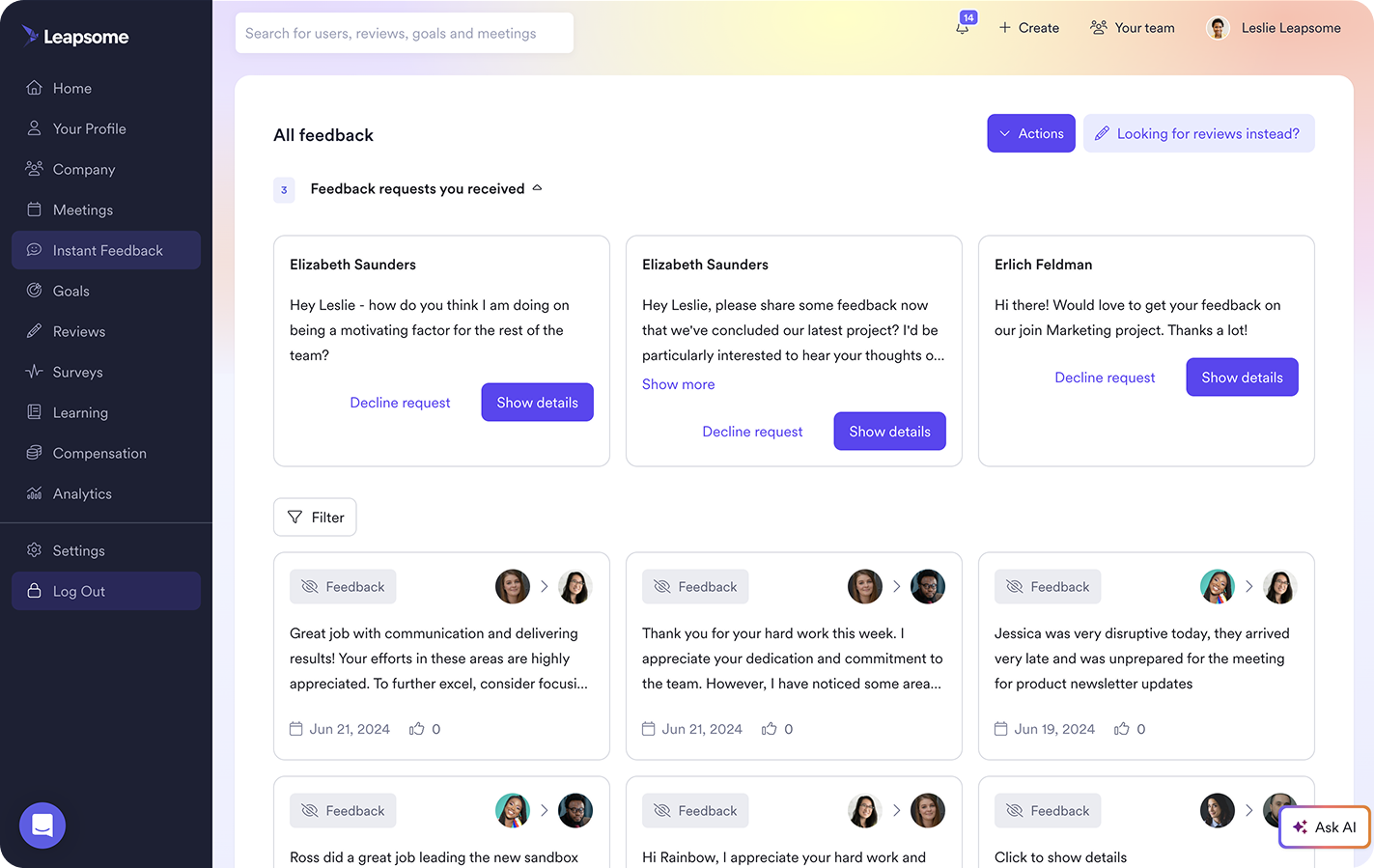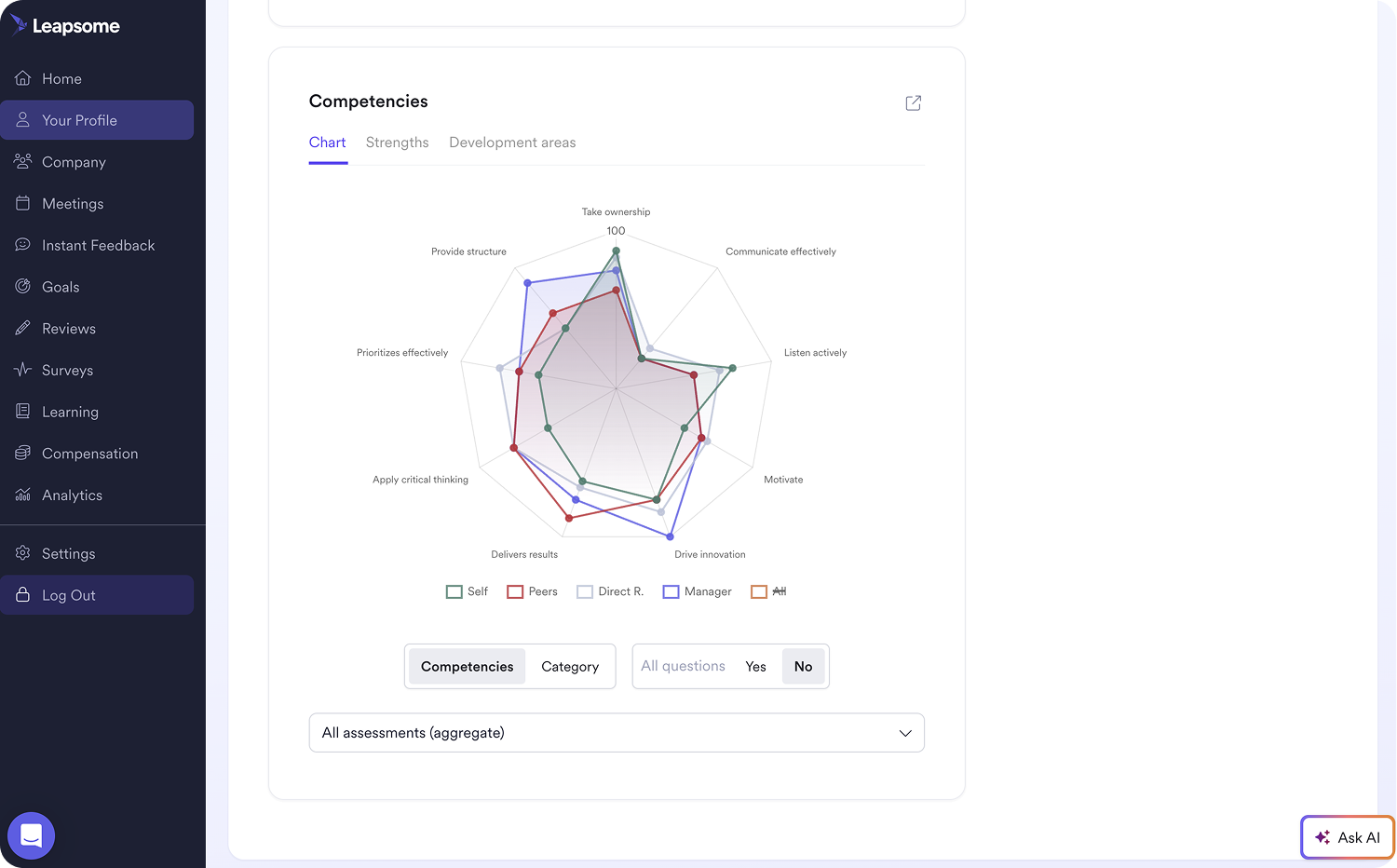A manager’s guide to better self assessments (with examples)

Growth-oriented organizations know the value of reflection and self-evaluation for both managers and team members. A constructive self-assessment is not just about listing completed tasks and achievements — it’s about empowering employees to take ownership of their career paths and understanding how they view their own performance as part of the wider picture.
In fact, Harvard found a positive correlation between self-reflection and improvement. According to the study, self-reflection can be even more beneficial than further practice.*
However, it can be difficult for team members to measure their own performance critically and objectively. Are there specific criteria or metrics they should consider? How can team leaders support them in the process?
In this guide, we’ll explore:
- Pointers you can provide to employees to help them write great self-evaluations
- Questions team members can ask themselves to aid in their reflections and self-assessments
- Five categories of example self-evaluation responses
- General best practice tips for writing excellent self-assessments
This will help you create a supportive environment that encourages honest reflection, sets clear evaluation criteria, and fosters constructive feedback.
*Harvard Business School, 2023
Pointers managers can provide to help employees write great self-assessments
It’s essential for team leads to empower and guide employees on how to write self-assessments that are impactful, honest, and growth-focused. Here are a few different ways you can support your reports with this:
1. Reflect on performance & goals

When employees complete self-evaluations, managers can better understand their goals and help them create tailored paths to achieve them
Firstly, ask team members to take a step back and think about the monthly, quarterly, or annual objectives they previously set — did they meet them, exceed them, or fall short?
Be sure to reinforce that self-evaluations don’t have to be all about the numbers — like sales figures, completed projects, customer satisfaction scores, deadlines, or revenue. Make it clear to employees that they’re also about the effort, progress, and learning that happens along the way.
“In performance reviews, managers need to help employees recognize their commitment to growth and development, even if they haven’t achieved all of their goals yet.”
— Aristida Markauskaite, HR Manager at RatePunk
2. Support statements with measurable outcomes
Encourage employees to be specific about the impact they delivered rather than using generic statements to describe their progress. When team members support what they write in their self-assessments with concrete examples and measurable outcomes, it increases credibility and demonstrates their achievements and areas of improvement more effectively.
For instance, instead of writing, “I improved customer satisfaction,” employees should use more specific phrasing such as “I implemented a new feedback system that resulted in a 20% increase in customer satisfaction ratings.”
3. Address personal strengths
Focusing on and honing in on strengths is a great way to consistently improve professional performance — and enjoy the process. In order to convincingly highlight their personal strengths in self-evaluations, employees should not hesitate to cite specific examples from peer feedback. Doing so not only provides a well-rounded perspective on their performance but also contributes to a deeper and more objective understanding of their unique strengths.
Holistic people enablement platforms like Leapsome make it easy for employees to exchange feedback about their projects, goals, and achievements. Our interconnected Reviews and Instant Feedback modules mean team members can easily refer to past perspectives from managers, coworkers, and reports to inform their self-assessments.
If individuals are curious about their performance in a certain context but have yet to receive feedback about it, they can use our request feedback feature to prompt responses in preparation for their next performance review.

Leapsome’s Instant Feedback module allows team members to easily share their perspectives to enable continuous development
🔄 Foster a culture of continuous feedback
Leapsome’s Instant Feedback module makes continuous dialogue flow naturally and drives team cohesion and growth.
👉 Learn more
4. Emphasize learning & development
Encourage employees to not just reflect on what they’ve learned and how they’ve grown since their last review but also to think about the knowledge and skills they would like to acquire next.
Many companies offer a learning budget that employees can use to pay for courses, conferences, or resources that will help them develop their skills further. Performance reviews are a great opportunity to remind employees of this budget and encourage them to include some suggestions for where to best allocate it in their self-assessment. If your organization does not have a budget for this, there are many great free online resources for learning that you can direct people to — such as Coursera, which has many industry-specific qualifications that employees can take part in completely for free.
Leapsome’s Learning module allows users to set up custom learning paths, helping employees plan out the next steps in their professional development. Plus, with our Competency Framework and Learning Analytics, managers are able to personalize career journeys and keep track of the objectives and ambitions of their direct reports to ensure that they are heading in a good direction.
.jpeg)
🔮 A holistic view of employee development
Leapsome’s analytics dashboard gives employees and their managers insights into their activity across all Learning Paths.
👉 Learn more
5. Set SMART goals for professional growth
If your company directly combines development planning and performance reviews, team members may find the SMART goal framework useful in the self-assessment process. It stands for:
- Specific
- Measurable
- Achievable
- Relevant
- Time-bound
All the SMART elements work together to give employees a sense of direction when identifying and working toward their goals. For example:
- Be specific — Instead of saying “improve leadership skills,” say something like “lead a team project to completion within the quarter.”
- Make it measurable — Ensure the progress and accomplishment of your goals can be quantified. For instance, “increase sales by [add percentage] in the next six months.”
- Keep it achievable — While goals should be challenging, they must also be realistic to maintain motivation and engagement. For instance, “reduce team overtime by [add percentage] in six months.”
- Ensure it’s relevant — The goals you set should be in line with your role, team, and organization’s broader objectives. A goal like “implement a new project management tool to increase team efficiency” would align with larger company productivity goals.
- Set time-bound targets — Always specify a timeframe, for example, “complete a professional certification course in digital marketing within the next [add period].” This provides a clear period in which to reach the end goal, making it easier to chart out a plan and measure progress.
However, establishing goals is only the first step — tracking progress is just as crucial. Leapsome’s Goals module lets you quickly set up SMART goals with customizable templates and a detailed, easy-to-understand analytics dashboard for added transparency and accountability.

Leapsome’s Goals module gives team members a clear view of their personal progress so they can stay organized and on track
Questions employees can ask themselves when writing self-evaluations
It’s common for people to undersell their accomplishments or struggle to objectively critique their performance. Here are some questions your team members can ask themselves to give direction to their reflections, get their creative juices flowing, and think about areas of improvement they might not have considered before:
- Have I met or exceeded the goals I set at the beginning of the evaluation period? Reflect on specific targets, projects, personal development, and general performance.
- How have I demonstrated initiative in my role? Consider instances where you’ve gone above and beyond, suggested new ideas, or taken on additional responsibilities.
- What feedback have I received from colleagues or leaders? How have I used it to improve? Remember the constructive criticism and praise you’ve had previously and how you acted upon it.
- What new professional relationships or networks have I built? Think about collaborations with other departments and external communities, as well as other contacts that have been beneficial to your work.
- How have I contributed to a positive work environment? Consider how you’ve supported colleagues, livened up team morale, or facilitated a respectful, inclusive atmosphere.
- How have I maintained work-life balance and managed stress? Reflect on how you’ve ensured your own well-being alongside your professional responsibilities.
- How do I handle failures or setbacks? Think about how you’ve demonstrated resilience and learned from mistakes.
- In what ways have I shown leadership skills, even if I’m not in a formal leadership role? Consider instances where you’ve influenced, guided, or supported others.
- How have I contributed to the company’s overarching mission or values? Discuss ways your work aligns with and advances the organization’s broader goals.
- What are my career aspirations, and how does my current role align with them? Reflect on your professional goals and how your present role will help you to achieve them.
Self-evaluation example responses to share with employees
Your team members may not know how to start filling out their self-evaluations, so offering them example responses can serve as useful tips or frameworks and get them inspired to begin writing.
Bill Catlette, Partner at Contented Cow Partners, shares his own self-appraisal structure. He usually begins each statement with a starting point, such as:
- Accomplishments I’m especially proud of
- Something I’d like to have a “do-over” on
- Something I’ll never do again
- Things I intend to make a habit of
- Something I could use help with
- Something I’m striving for
Here are some additional practical examples you can share to guide team members’ self-assessments. We’ve placed them in five categories:
- Performance and goals
- Problem-solving
- Professional growth
- Interpersonal skills
- Time management
1. Performance & goals
Strength areas
- I exceeded my targets by [add percentage], which is a testament to my dedication to my performance goals.
- My ability to lead and motivate my team has led us to surpass our project delivery deadlines three times this year.
Growth areas
- While I met most of my deadlines, I recognize the need to improve my prioritization skills to manage multiple tasks better.
- I aim to better balance long-term projects with short-term requests to ensure I meet all my performance targets consistently.
2. Problem-solving
Strength areas
- My ability to think outside the box has allowed me to find innovative solutions to problems, such as when I developed a new workflow that increased our department’s efficiency by [add percentage].
- I’ve effectively managed crises, like the server outage last month, which I resolved in record time to minimize downtime.
Growth areas
- I plan to improve my collaboration skills to leverage team members’ expertise when addressing problems.
3. Professional development
Strength areas
- I enrolled in an advanced data analysis course that has significantly improved my work productivity and accuracy.
- I’ve utilized the feedback from my last review, notably improving my presentation skills and increasing my meeting contributions.
Growth areas
- I aim to expand my professional network to gain fresh insights and perspectives on the industry.
- I plan to seek out a mentor within our organization to further aid my professional growth and my wider understanding of our business.
4. Interpersonal skills
Strength areas
- My coworkers often compliment my ability to remain calm and positive under pressure, contributing to a healthier work environment.
- My communication skills are effective in both 1:1 and group settings, which enhances team collaboration, as highlighted in a recent peer review.
Growth areas
- I need to work on my assertiveness in team meetings to ensure I make my ideas heard.
- While I’m comfortable working as part of a team, I want to improve my skills in managing conflict and disagreement.
5. Time management
Strength areas
- I’ve consistently met project deadlines this year and efficiently prioritized my tasks to maintain a steady workflow.
- By effectively using project management tools, I’ve enhanced my ability to track and manage multiple tasks and deadlines.
Growth areas
- I need to improve on delegating tasks to ensure my work is evenly distributed and I can focus on my core responsibilities.
- To better manage my time, I plan on refining my organizational skills, focusing on reducing procrastination and interruptions.
Tips on writing self-evaluations

Some team members may not be comfortable filling out self-assessments, so managerial encouragement and guidance can go a long way
Share these strategies with your employees to help them produce effective and valuable self-assessments.
Be honest & objective
Ideally, staff members should share a balanced view on areas of growth and praise in their self-evaluations. To make that easier, encourage them to view their performance from a third-person perspective — this often helps people think more objectively and accurately.
For example, an employee could ask themselves questions such as “If I were my manager, how would I assess my contribution to this project?” or “If I were an outsider looking in, would I see a team player who consistently meets deadlines and goes the extra mile?”
This third-person perspective allows people to separate their emotions from their performance, allowing for a balanced and constructive evaluation of their own work.
Highlight growth, not just accomplishments
Many people have a habit of only considering ‘big’ wins when it comes to self-evaluations. They might only view something as a success if they accomplished 100% of a goal, landed an exciting new client, or launched a large project.
While these bigger accomplishments are fantastic, it’s equally important to encourage team members to highlight the smaller wins as a step toward longer-term achievements in their self-assessments.
For instance, a team member might not have reached the objective of ‘improving customer satisfaction rates by 15%’ this quarter. However, they might have invested time in customer service courses and started to feel more confident in customer calls. Those initiatives deserve recognition, too, as they are important steps on the journey to the larger goal.
Acknowledge areas for improvement
Empower employees to identify and accept areas where they need to improve their performance as opportunities for growth. It’s okay to stumble; what’s important is that they’re learning and improving.
For example, a team member might write, “I found I struggled with time management when juggling multiple client projects. I plan to undertake a time management course to improve in this area.”
Use specific examples & data
Equip employees with the power of specifics. That way, they can do more than just say they did a good job on something — they can explain the granular, positive impacts their actions had. Details and data also help reduce bias and increase credibility and objectivity when it comes to self-assessment.
For example, instead of saying, “I improved customer satisfaction,” a team member could detail, “By implementing weekly follow-up calls with clients, I increased customer satisfaction rates by 20% over six months.”
🔍 Transform performance evaluations
Leapsome’s Reviews module supercharges assessments with cross-cycle analytics, customizable roadmaps, and targeted frameworks.
👉 Learn more
Prioritize personal & professional development with Leapsome

Leapsome’s Reviews module saves time with automated cycles and easy-to-understand analytics
Self-evaluations are a golden ticket to self-awareness and professional growth. But simply guiding employees to write down their thoughts will prevent you from getting the most out of the process. You need robust tools that help you evaluate and conduct assessments clearly, fairly, and transparently.
Leapsome can help you do just that with our Learning, Goals, Instant Feedback, and Reviews modules:
- Reviews gives employees access to previous peer, manager, and report feedback, along with their earlier self-evaluations, directly within the self-assessment writing tool. Plus, our customizable templates, automated reminders, and robust analytics help leaders and team members develop a deeper understanding of employee development.
- Instant Feedback provides staff with continuous insights into how their managers and peers view their performance and empowers them to request feedback in preparation for future self-evaluations.
- Goals allows users to set and track individual, team, and company objectives in real-time, providing a clear view of their development trajectory and their impact on business success.
- Learning paves the way for dynamic employee development journeys with custom learning paths, a library of educational content, and quizzes so team members can check and enrich their skills regularly. As a result, they’ll better understand their strengths and areas of improvement, resulting in more meaningful self-evaluations.
After all, performance reviews aren’t just about ticking boxes but cultivating a culture of continuous feedback and growth.
🚦 Give employee development the green light
Leapsome can transform performance reviews into powerful growth accelerators.
👉 Book a demo
Ready to transform
your People operations?
Automate, connect, and simplify all HR processes across the employee lifecycle.
.webp)
.webp)
 Request a demo today
Request a demo today








.jpg)




















